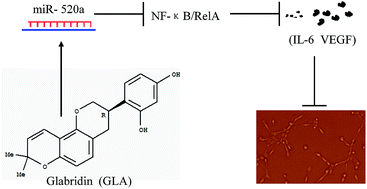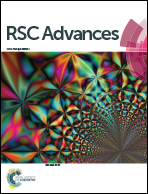The repressive effect of miR-520a on NF-κB/IL-6/STAT-3 signal involved in the glabridin-induced anti-angiogenesis in human breast cancer cells†
Abstract
The formation of blood vessels plays a vital role in the growth of tumors. Breast cancer is a type of vascular dependent tumor, and angiogenesis plays an important role in its invasion and metastasis. Thus, the continued search for new mechanisms that inhibit the formation of blood vessels is becoming a strategy for the treatment of breast cancer. Glabridin (GLA) is a novel anti-tumor agent that inhibits oxidization, inflammation, and proliferation in human cancer cells. However, the functions of GLA in the regulation of angiogenesis in breast cancer and its underlying molecular mechanisms remain largely uninvestigated. In our present study, GLA attenuated the angiogenic ability by the microRNA-520a (miR-520a)-mediated inhibition of the NF-κB/IL-6/STAT-3 signal pathway in MDA-MB-231 and Hs-578T cells. Briefly, in these cells, GLA up-regulated the expression of miR-520a in a time-dependent manner; miR-520a, which targeted the NF-κB/RelA-3′UTR, decreased the expression/function of NF-κB, leading to the inactivation of IL-6/STAT-3 signaling; the knockdown of miR-520a abolished the GLA-induced inhibitions of the NF-κB/IL-6/STAT-3 signal pathway, the VEGF secretion, and the angiogenesis. By understanding the novel mechanism in which GLA inhibits the angiogenic potential in human breast cancer cells, our study would help in the design of future strategies in terms of developing GLA as a potential chemopreventive agent, when used alone or in combination with other current anticancer drugs.


 Please wait while we load your content...
Please wait while we load your content...